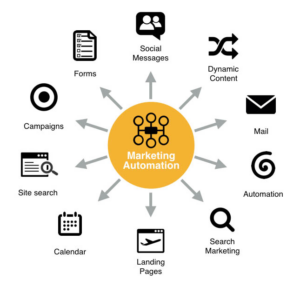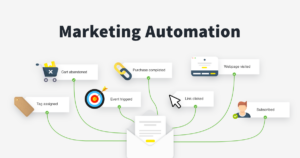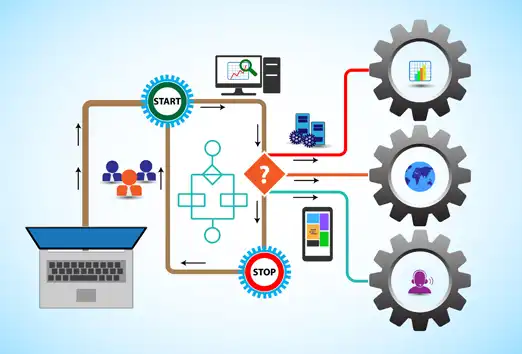Efficiency is key, and mastering marketing automation can be the game-changer your business needs. Imagine seamlessly managing your campaigns, nurturing leads, and delivering personalized content—all while saving time and resources. With Selly Africa, a powerful marketing automation tool designed to help businesses thrive, you can transform your marketing efforts into a streamlined workflow that works for you, not against you. In this post, we’ll walk you through the essential processes of setting up your marketing automation workflow with Selly Africa, empowering you to engage your audience more effectively and drive conversions like never before.
Understanding marketing automation and its benefits

Understanding marketing automation is crucial for any business looking to streamline its marketing efforts and maximize efficiency. Marketing automation refers to the use of software to automate repetitive tasks across various marketing channels. This technology enables you to nurture leads, manage campaigns, and analyze customer interactions without the constant need for manual intervention. In the context of Selly Africa, this means harnessing the platform’s powerful tools to create a seamless workflow that caters to your specific business needs.
The benefits of marketing automation are manifold. First and foremost, it saves time. Automating routine tasks such as email campaigns, social media posting, and customer segmentation, your team can focus on strategic initiatives that drive growth. Imagine having more hours in your day to brainstorm creative ideas or develop new products, all while maintaining consistent communication with your audience.
Additionally, marketing automation enhances personalization. With the ability to track customer behavior and preferences, you can tailor your messaging and offers to resonate with your target audience. This level of personalization fosters stronger relationships and increases the likelihood of conversion, as customers feel understood and valued.
Moreover, marketing automation provides valuable insights through comprehensive analytics. Tracking campaign performance and customer engagement helps in identifying what works and what doesn’t, allowing you to refine your strategies over time. This data-driven approach not only boosts your marketing efficiency but also empowers you to make informed decisions that align with your business objectives.
Account setup and integration with Selly Africa
Getting started with Selly Africa is an exciting first step towards mastering marketing automation, and it all begins with a seamless account setup and integration process. As you embark on this journey, the first thing you’ll need to do is create an account on the Selly Africa platform. The registration process is straightforward—simply provide your email address, create a strong password, and verify your account through a confirmation email. Once you’re in, you’ll be greeted by an intuitive dashboard that serves as your command center for all automation tasks.
Next, it’s time to integrate Selly Africa with your existing tools and platforms. Selly Africa supports a variety of integrations, making it easy to connect with your eCommerce store, CRM, and other marketing tools. Whether you’re using Shopify, WooCommerce, or any other platform, you can follow the step-by-step integration prompts provided by Selly Africa. This ensures that all your customer data, sales information, and marketing efforts are aligned and synchronized.
As you set up your account, take advantage of the onboarding resources offered by Selly Africa, including tutorials, FAQs, and customer support. These resources will help you navigate through initial setup challenges and maximize the platform’s capabilities. With a solid foundation in place, you’ll be ready to customize your workflows and unlock the full potential of marketing automat
Common marketing automation workflows for Selly Africa stores
- Welcome email workflow: Send a welcome email to new customers, offering a discount or exclusive content.
- Abandoned cart workflow: Remind customers about abandoned carts with a series of emails
- Post-purchase follow-Up: Send thank-you emails, request product reviews, and offer cross-selling opportunities.
- Customer winback workflow: Re-engage inactive customers with special offers or personalized recommendations.
- Birthday and anniversary campaigns: Send personalized messages and promotions on special occasions.
ion tailored specifically to your business needs. Whether you’re looking to streamline your email campaigns, automate social media posting, or create personalized customer journeys, getting started with Selly Africa sets the stage for a more efficient and effective marketing strategy.
Designing your marketing automation workflow

Designing your marketing automation workflow with Selly Africa is a crucial step that will set the foundation for effective customer engagement and streamlined operations. The first thing to consider is your specific goals—what do you want to achieve with automation? Whether it’s nurturing leads, increasing conversions, or enhancing customer retention, having clear objectives will guide your entire design process.
Start by mapping out your customer journey. Understanding how potential customers interact with your brand at various touchpoints will help you create a tailored workflow that resonates with their needs. Identify key stages in this journey, such as awareness, consideration, and decision, and think about what type of content and communication would be most effective at each stage.
Next, utilize Selly Africa’s intuitive interface to create a visual representation of your workflow. Begin with a trigger—this could be an action taken by a user, such as signing up for a newsletter or abandoning a cart. From there, outline the specific actions that should follow. For example, after a user subscribes, you might want to send a welcome email, followed by a series of informative emails that provide value and guide them towards making a purchase.
Don’t forget to incorporate segmentation into your workflow design. Categorizing your audience based on factors like demographics, behaviors, or past interactions can tailor your messaging for each group, making your automation more personalized and effective. Selly Africa allows for dynamic content creation, meaning you can adjust your messaging in real-time based on user responses.
Finally, ensure that your workflow includes feedback loops. This means setting up triggers for actions like clicking a link or making a purchase, which can help refine your automation strategy over time. Regularly review performance metrics, such as open rates and conversion rates, to identify areas for improvement. In continually optimizing your workflow, you’ll be better positioned to meet your marketing goals and provide an exceptional experience for your customers.
Designing your marketing automation workflow with Selly Africa may seem daunting at first, but by breaking it down into manageable steps and focusing on your audience’s journey, you can create a powerful system that not only saves you time but also enhances your overall marketing efforts.
Creating personalized campaigns and content
Creating personalized campaigns and content is a pivotal step in mastering marketing automation, especially when using a platform like Selly Africa. Personalization goes beyond just inserting a recipient’s name in an email; it’s about understanding your audience’s preferences, behaviors, and needs to deliver tailored messaging that resonates.
To start, segment your audience based on various criteria such as demographics, purchase history, and engagement levels. This segmentation allows you to create targeted campaigns that speak directly to different groups within your audience. For example, you might have a segment for first-time buyers, another for loyal customers, and a third for those who haven’t engaged with your brand in a while. Each group will benefit from distinct messaging that addresses their unique circumstances.
Next, leverage the data and insights gathered from your audience interactions to craft relevant content. Consider using dynamic content blocks within your emails or landing pages, which change based on the viewer’s segment. For instance, a returning customer might see recommendations for complementary products based on their previous purchases, while a new subscriber could receive a welcome series that introduces them to your brand’s story and values.
Additionally, utilize automated triggers to send personalized messages at key moments in the customer journey. This could include sending a special discount code on a customer’s birthday or a follow-up email after a purchase to request feedback or suggest related products. These thoughtful touches not only enhance the customer experience but also build loyalty and drive repeat business.
Finally, A/B testing is an invaluable tool in refining your campaigns. Experiment with different subject lines, email designs, and calls to action to see what resonates best with each segment. Analyzing the results will provide valuable insights into the effectiveness of your personalized content and help you continuously improve your approach.
Measuring ROI
Measuring the return on investment (ROI) for your marketing automation campaigns is crucial to understanding their effectiveness and justifying your expenditure. To begin calculating ROI, you will need to track both the costs associated with your marketing automation efforts and the revenues generated as a result. Here’s a step-by-step approach to help you navigate this process.
1. Identify costs: Start by compiling all the costs related to your marketing automation campaigns. This includes the subscription fees for your automation software, any additional tools or integrations you may be using, costs for content creation, digital advertising, and labor costs associated with managing the campaigns. Having a clear picture of your total investment is essential for an accurate ROI calculation.
2. Track revenue generated: Next, you need to determine the revenue generated directly from your marketing automation efforts. This can be done by analyzing sales data and attributing it to leads or conversions that were nurtured through your automation workflows. Use tracking links, custom UTM parameters, or CRM software to help identify which sales originated from your marketing campaigns.
3. Calculate ROI: With your total costs and revenue figures in hand, you can now calculate your ROI using the following formula:
The basic formula for calculating ROI is:
ROI = ((Net Profit / Cost of Investment) * 100)
Where:
- Net Profit: The total revenue earned from the investment minus the total costs incurred.
- Cost of Investment: The initial investment amount.
Example Calculation
Let’s say you invest $10,000 in a marketing campaign that generates $15,000 in revenue. The associated costs (excluding the initial investment) for the campaign were $2,000.
- Net Profit: $15,000 (revenue) – $2,000 (costs) = $13,000
- ROI: ($13,000 / $10,000) * 100 = 130%
Therefore, the ROI of your marketing campaign is 130%.
This formula gives you a percentage that reflects the return on each dollar spent on your marketing automation efforts. A positive ROI indicates that your campaigns are profitable, while a negative ROI suggests the need for adjustments.
4. Analyze performance metrics: Beyond just the financial return, it’s essential to evaluate other performance metrics such as lead conversion rates, customer engagement, and customer lifetime value (CLV). These metrics can provide deeper insights into the effectiveness of your campaigns and highlight areas for improvement.
5. Iterate and optimize: Once you’ve calculated your ROI and analyzed the performance metrics, use this data to refine your marketing automation strategies. Identify the tactics that yielded the best results and focus on those while optimizing or discontinuing underperforming elements of your campaigns.
Best practices for continuous improvement and growth
Mastering marketing automation is not just about setting up your workflows; it’s also about continuously refining and optimizing them to ensure sustained growth and effectiveness. Here are some best practices to keep in mind as you embark on this journey with Selly Africa.
First and foremost, always be data-driven. Regularly analyze the performance of your campaigns to identify patterns and trends. Gather insights from key performance indicators (KPIs) such as open rates, click-through rates, and conversion rates. Selly Africa’s robust analytics tools allow you to visualize this data easily, making it simple to pinpoint what’s working and what needs adjustment.
Next, don’t be afraid to A/B test your content and workflows. Experimentation is a powerful tool in your marketing. Test different subject lines, email layouts, and call-to-action buttons to see what resonates most with your audience. By making small adjustments and measuring their impact, you’ll be well-equipped to refine your strategies continuously.
Another essential practice is to keep your audience segmented and personalized. As your customer base grows, so do their preferences and behaviors. Utilize Selly Africa’s segmentation features to tailor your messaging for various audience groups. This personalization will enhance engagement and drive better results, as customers are more likely to respond positively to content that speaks directly to their needs and interests.
Moreover, stay updated with the latest trends in marketing automation and technology. The digital landscape is ever-evolving, and being aware of new tools and strategies will keep your marketing efforts fresh and impactful. Regularly participate in webinars, workshops, and forums within the Selly Africa community to learn from industry experts and peers.
Finally, ensure that you solicit feedback from your team and your audience. Internal reviews can help fine-tune your processes, while customer feedback provides valuable insights into their experiences. Use this information to make informed decisions on how to enhance your workflows and campaigns.
Overcoming challenges and glimpsing the future of marketing automation
While marketing automation offers immense potential, implementing it successfully comes with its own set of challenges. Addressing these obstacles head-on is crucial for maximizing the benefits of automation.
Common challenges in marketing automation
- Data quality issues: Inaccurate or incomplete customer data can hinder personalization efforts and lead to ineffective campaigns.
- Integration complexity: Integrating multiple marketing tools and platforms can be time-consuming and error-prone.
- Measuring ROI: Determining the exact return on investment for marketing automation can be challenging.
- Overcoming personalization fatigue: Balancing personalized experiences with avoiding overwhelming customers
Solutions and best Practices
- Data cleansing and enrichment: Regularly clean and update customer data to ensure accuracy. Utilize data enrichment tools to fill in missing information.
- Streamlined integrations: Choose marketing automation platforms with robust integration capabilities. Consider using middleware solutions if necessary.
- Clear KPIs: Define specific, measurable, attainable, relevant, and time-bound (SMART) goals for your marketing automation campaigns. Track key metrics like open rates, click-through rates, and conversion rates.
- A/B testing: Experiment with different approaches to identify what works best for your audience.
- Human touch: Combine automation with personalized human interactions to create a balanced customer experience.
Common marketing automation mistakes
While marketing automation offers incredible potential to streamline your processes and enhance your engagement, there are common pitfalls that can derail even the most well-intentioned campaigns. One prevalent mistake is neglecting to segment your audience effectively. Sending generic messages to your entire list can lead to low engagement rates and high unsubscribe numbers. Instead, take the time to categorize your audience based on their behavior, interests, and demographics. This allows you to tailor your messaging, ensuring that each recipient finds value in what you share.
Another frequent error is over-automation. It can be tempting to set your workflows on autopilot, but this approach risks losing the personal touch that is essential in marketing. Automated messages should still feel personal and relevant. Strive to incorporate human elements, such as addressing recipients by name and customizing content based on their interactions with your brand.
Moreover, failing to regularly review and adjust your automation strategy is a critical oversight. Marketing trends and customer preferences evolve, so it’s important to analyze your data, identify what’s working, and make necessary adjustments. Ignoring this ongoing evaluation can lead to stagnant campaigns that no longer resonate with your audience.
Finally, many marketers underestimate the importance of comprehensive training and onboarding when implementing tools. Relying solely on automated systems without understanding their capabilities can lead to ineffective use. Invest time in learning the ins and outs of the platform to fully leverage its features and maximize your marketing efforts.
The future of marketing automation
Marketing automation is constantly evolving, driven by technological advancements and changing consumer behaviors. Here are some emerging trends to watch:
- Hyper-personalization: Leveraging AI and machine learning to deliver highly tailored experiences based on individual preferences and behaviors.
- Predictive analytics: Using data to anticipate customer needs and proactively offer solutions.
- Integration with IoT: Connecting marketing automation with smart devices to create seamless customer journeys.
- Conversational marketing: Utilizing chatbots and virtual assistants to engage with customers in real-time.
- Privacy and ethics: Addressing concerns around data privacy and ethical marketing practices.
Conclusion
Mastering marketing automation with Selly Africa is a transformative step for any business looking to streamline its processes and engage more effectively with its audience. The beauty of marketing automation lies in its ability to save you time, reduce manual effort, and provide insights that can refine your marketing approach. As you implement what you’ve learned, remember that the key to success is continuous optimization. Regularly analyze your campaigns, gather feedback, and make adjustments to ensure your efforts align with the evolving preferences of your audience.
Ultimately, the goal of mastering marketing automation is to create meaningful connections that drive engagement and boost conversion rates. With Selly Africa as your partner, you’re well-equipped to navigate the complexities of digital marketing and achieve your business objectives. Embrace this journey of innovation and efficiency, and watch your business thrive in an increasingly competitive landscape.

